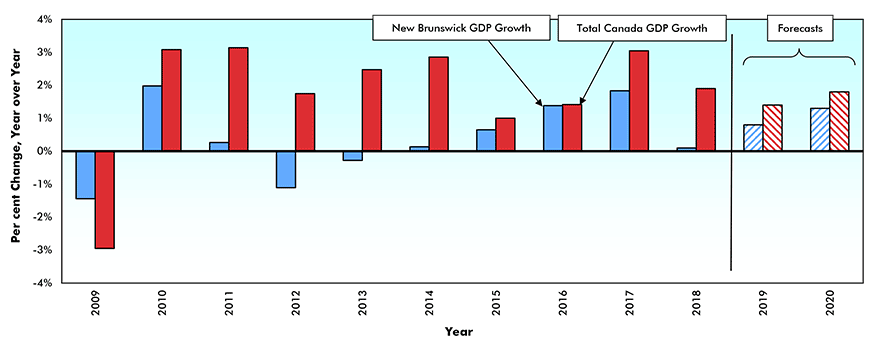Although it is facing persisting headwinds, we expect the New Brunswick economy to pick up speed as it heads into 2020 after almost stalling in 2018.
Despite sustained at or above potential growth in the United States, the market for 87% of its exports, New Brunswick’s total exports are down 7.4% compared to a year earlier. This retreat is primarily due to a price-induced drop in exports of petroleum products that was only partly offset by stronger sales of seafood (both crabs and live lobsters), military vehicles and potatoes.
Also, the drop in petroleum exports was exacerbated by the impact of maintenance and the subsequent fire at the Irving oil refinery. Going forward, with the refinery back to full capacity and oil prices up over 20% since the beginning of the year, exports should have a positive impact on New Brunswick’s growth during the remainder of this year and into 2020.
New Brunswick’s second headwind is a pause in planned capital spending. According to the Atlantic Provinces Economic Council’s (APEC) Major Projects Inventory, spending on large capital projects will contract by 9% this year and by a further 6% in 2020. While the investment picture described by Statistics Canada’s Non-residential capital and repair expenditures (CAPEX) survey is not quite as bleak as is APEC’s, both surveys lay much of the blame for the weak investment outlook on a $260 million reduction in the provincial government’s annual capital budget.
Another contributing factor is the completion of maintenance and upgrades to Irving Oil’s Saint John refinery. Despite this pullback in public sector capital spending, private sector capital spending is projected to increase next year and beyond fuelled by increased spending on cannabis production, aquaculture projects, the expansion of the Port of Saint John and on upgrades to the Mactaquac generating station .
This more upbeat near-term outlook for New Brunswick is due in part to an improvement in consumer and business confidence.
Both appear to be making a material contribution to the Picture Province’s growth heading into 2020. Driven (literally) by a 6.3% increase in motor vehicle sales, retail sales are up by 2.7% year to date (ytd), more than double the 1.3 percentage-point gain during the same period in 2018.
Fuelled by the largest net annual inflow of international migrants since 1975 and a solid 6,000 increase ytd in full-time employment, housing demand in the province has also exhibited a significant pick-up.
Existing home sales, year to date, are up by a country-leading 17.7% compared to a -7.9% y/y decline a year earlier. This solid increase in housing demand has given a strong boost to new residential construction. Housing starts in the province are up by 47% ytd, more than seven times their 6% y/y increase in the first half of 2018.
In light of the very strong inflow of international migrants and the fact that the province’s rental vacancy rate hit an 18-year low in late 2018, it is not surprising that the jump in total housing starts was driven in large part by a 183% ytd increase in apartment starts that more than offset declines in starts of single-family and row housing units.
Given the 31% ytd surge in residential building approvals and a significant jump in new residential construction, we expect housing starts for the year to total in the range of 2,300 to 2,500 units this year and 2,000 to 2,300 in 2020 compared with 2,300 in 2018.
Consistent with the improvement in consumer confidence, the latest (July) Canadian Federation of Independent Business “Business Barometer for New Brunswick” has trended steadily higher over the past four months.
In July, it rose by 4 points to reach its highest value since the beginning of the year. This increase was accompanied by a healthy rise in private sector hiring plans. A net 13% of respondents to the CFIB survey planned to add staff, up from 2% the previous month. Further, the job vacancy rate in the province, currently at 2.8%, is the highest it has been in more than 14 years.
Given the evidence of stronger consumer spending and residential construction, plus the improved outlook for exports, we expect the New Brunswick economy to grow in the range of 0.5% to 1.2% this year and by 1.0% to 1.5% in 2020, after almost no growth (0.2%) in 2018.
John Clinkard has over 35 years’ experience as an economist in international, national and regional research and analysis with leading financial institutions and media outlets in Canada.
Real* Gross Domestic Product (GDP) Growth —
New Brunswick vs Canada

* “Real” is after adjustment for inflation.
Data Sources: Actuals — Statistics Canada; Forecasts — CanaData.
Chart: ConstructConnect — CanaData.











Recent Comments
comments for this post are closed